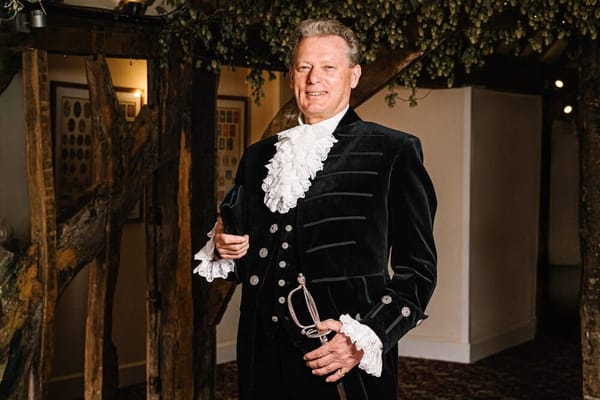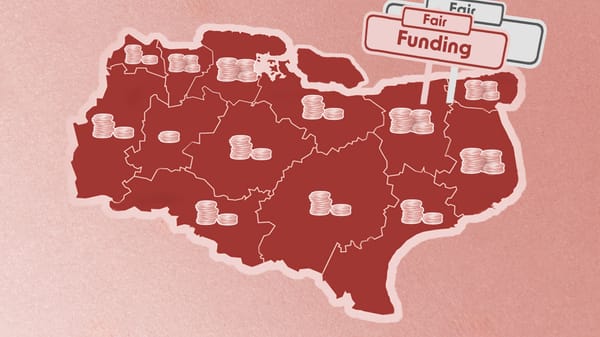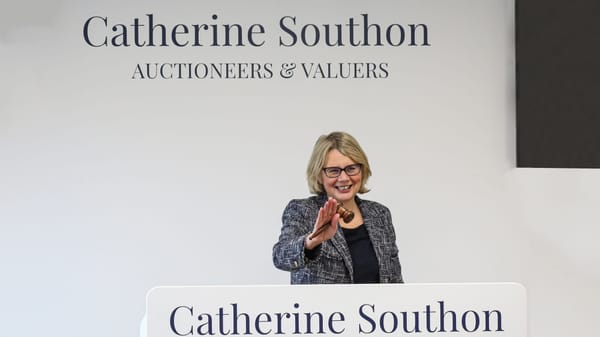“I don't think I'm much of a performer"
We speak to Ralph Steadman, legendary illustrator.
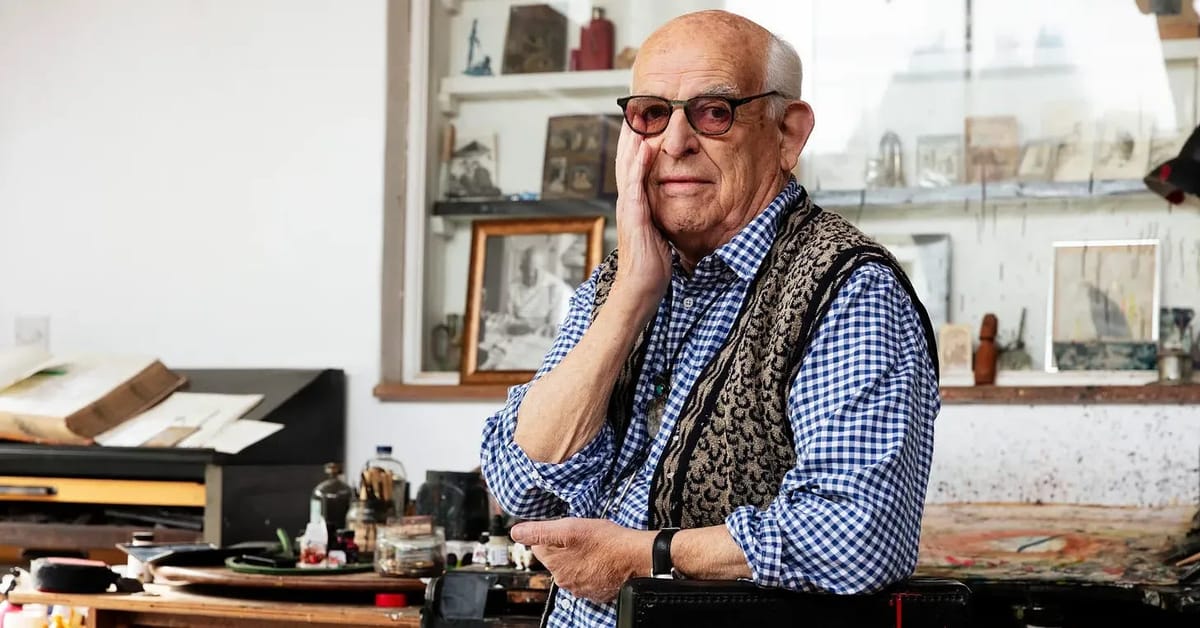
Ralph Steadman is a renowned political cartoonist known for his collaborations with Hunter S Thompson. Having successfully exhibited his extensive collection of work at the Chatham Historic Dockyard last year, his INKling Exhibition is now touring the country. Steven caught up with Ralph and his daughter Sadie Williams, Managing Director of the Ralph Steadman Art Collection, where they talked about Ralph’s national service, meeting Hunter S. Thompson, cats, and lots more.
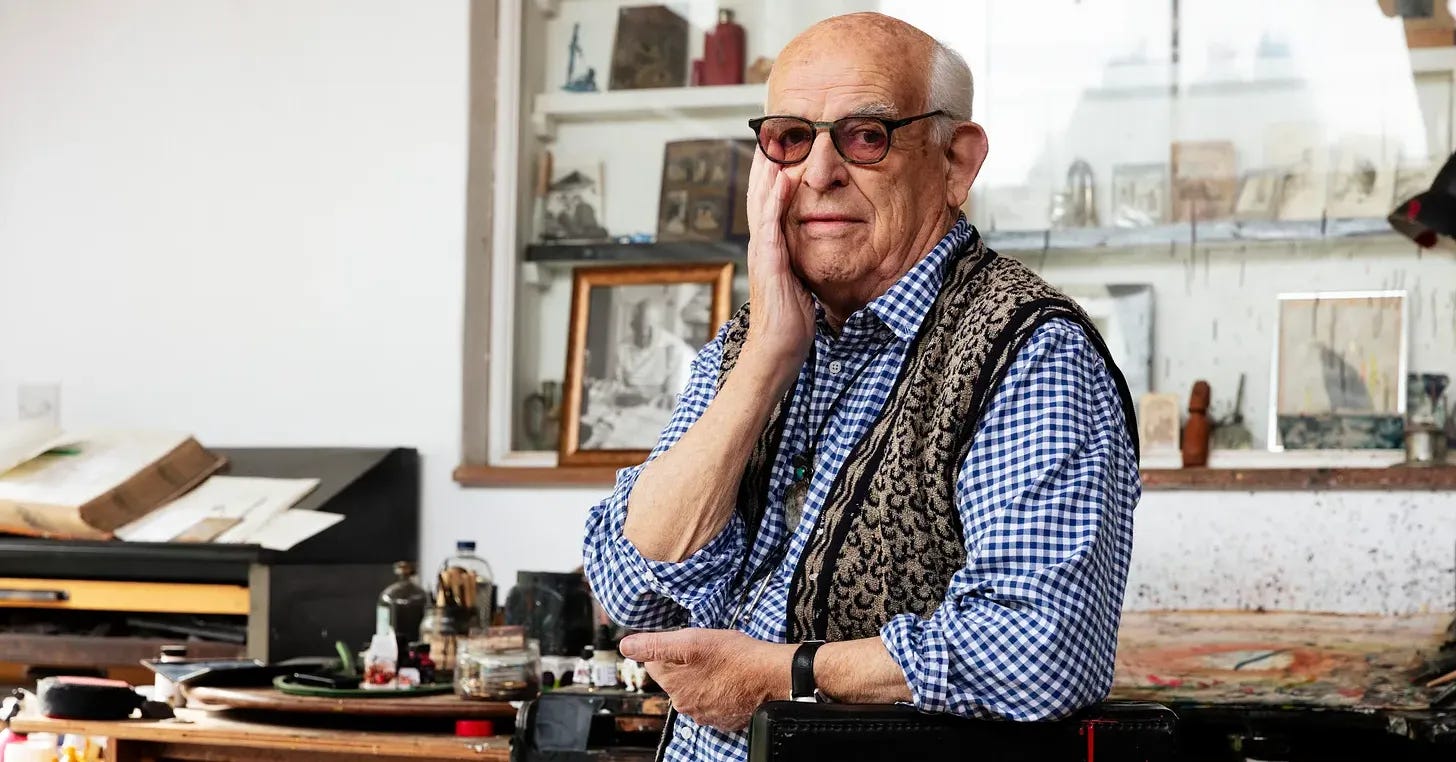
Ralph: Anyway, what are we talking about?
I've got some questions for you. I’m just getting myself set up.
What is the INKling exhibition?
Sadie: Should I talk about that?
Ralph: That's clever, yeah. You talk about it.
Sadie: Basically, it was originally designed for Chatham Historic Dockyard, which is quite a big gallery. It's four different sides of dad's career. You've got literary artworks. He's illustrated lots of literary classics in his time, like Alice in Wonderland, Treasure Islands, Fahrenheit 451 and Animal Farm. I wanted to showcase those because they're so beautiful, because when they're in the books, they're quite small, but the actual originals, they're really big, they're A1. It's a different experience. I really want people to have that, and then I've always wanted people to see more of his children's artworks. There's an entire wall of children's book illustrations which go back to 1963 with Fly Away Peter through to 2023 when he did the Ralphabet. I think it works as a mini retrospective because you can really see the change in the penmanship, and when you hit the 1980s, you see how things changed a bit in the 70s. Then you've got the Gonzovation works, the collaboration with Ceri Levy, which started in 2010 and now numbers over 300 original drawings in the entire collection. They're just so beautiful. They're all A1s and about conservation, endangered and extinct birds and animals, but they're so colourful and exuberant that they're just a lovely selection to show. And then you've got the Gonzo and Hunter (S Thompson) wall because I knew people would want to see those pieces. I think there's seven portraits of Hunter. The exhibition space in Pinner is quite a lot smaller. We did have to make a few edits, but I wanted to put as much art on the walls as possible. It's quite an assault when you go in, it's like, ‘wow,’ but it's really cool. I'm really pleased with how it looks. They've done an absolutely fantastic job presenting it all. Then, around the back is the wow moment: There's a replica of dad's drawing desk, with all the old ink bottles. I was collecting ink bottles and old pens for months to make sure we had enough that I could dress. It's to size, that’s quite nice. You can have a picture by it. That's the selfie spot.
Ralph: You’ve done far better than I would at explaining it.
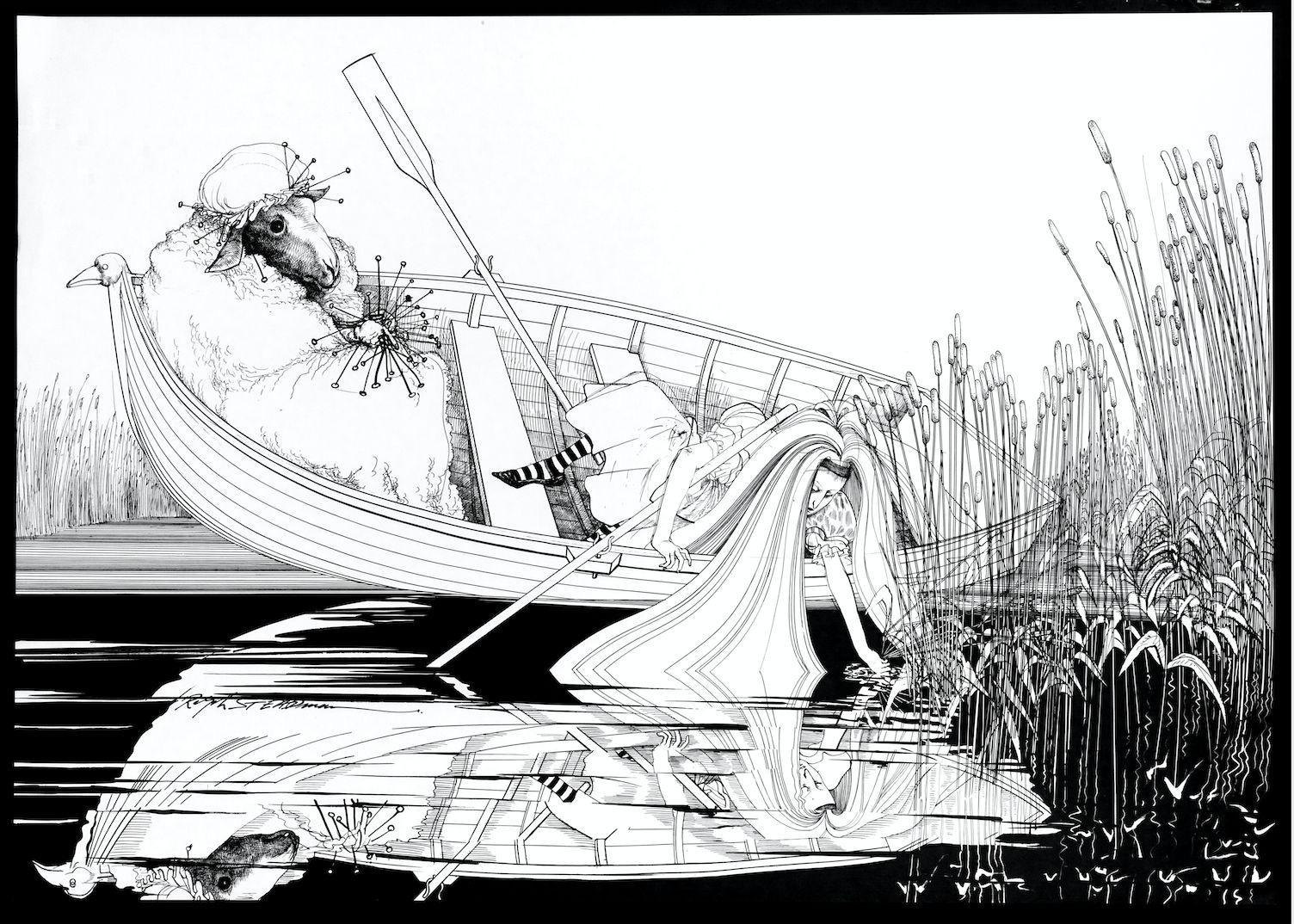
I read this is your first exhibition in a decade. Why have you decided to do one now?
Sadie: In the UK, yeah.
Ralph: Me? I didn't have any choice.
Sadie: We were asked to do it. The Dockyard had the support to help us to put this together. It's such a lot of work to put an exhibition together that I obviously thought, let's see if we can find some other venues. Then a friend of Ceri Levy’s got in touch because he's the curator at the Heath Robinson Museum, and he wants an exhibition. We had this exhibition, and it could be free after September. It's just really nice to present it to new audiences, reformat it, freshen it up a bit, so we are hoping to tour it across the UK eventually. It's just finding more venues.
Do you enjoy the process of exhibition?
Ralph: It gets difficult when you're beyond a certain age. You can’t do much. There has been the odd unexpected meeting, and then that develops into a chat with people. That develops into a chatterbox, then you get a little more interested in what you're supposed to be doing without falling asleep on the sofa.
Is there anything when you were putting the exhibition together that you'd forgotten about that it was nice to see again?
Ralph: There was lots I had forgotten about. I wonder how did I come to do that? I get so enthused by doing it. Parts of me are sad that I miss doing things. It's happened to lots of artists the same way, I think. They all start off full of ambition to do this, that, and God knows what else. As I say, I started to sing as I tackled the thing that couldn't be done, and I did it. That's how I think of the things these days. Luckily Sadie's here with her enthusiasm for doing something.
Going to East Ham is kind of an odd place to go. It’s quite a tough place. I mean, it's not very hard if we end up here in Kent in a large house.
Was there a particular part of the exhibition that you enjoyed seeing again?
Ralph: Gonzovation, I think. It's interesting. There are quite a few things early in life you forget. I mean, I did a Percy V. Bradshaw Press Art School course once.
Sadie: It was the first thing you did after your national service.
Ralph: I thought it was the other way around.
Sadie: You went to London and enrolled in East Ham Tech College.
Ralph: Yes, that's right. Going to East Ham is kind of an odd place to go. It’s quite a tough place. I mean, it's not very hard if we end up here in Kent in a large house.
Do you remember what brought you to Kent?
Ralph: We got through the post from an estate agent. Saying there is this place down in Kent, are you interested? We have never thought about it.
Where would you have been living at the time?
Ralph: New King's Road, London. This place came through the post. Apparently, there's now a thing on the wall that says I lived at that place.
Sadie: Apparently, it’s not real, though. A fan has put it up.
Ralph: Oh dear. Does that mean it's been taken down again?
Sadie: No, I think it's still there, but it's not an official plaque. It's a guerilla, stealth one, I think.
Yes, it is strange that. I did radar operating, which is a way of learning how to watch television really. That's what I sort of did in the end, and it served me well. I know how to watch television.
Ralph: What do you do? What are you doing most of the time?
We run a local news website predominantly based in Medway. We're not trained journalists, we're just two residents who felt we could provide independent news to a good standard. I started doing these long sit-down interviews, and now we have started covering Kent.
Ralph: Wow. Oh, well, that's good. What would you call yourself then, as a person doing this?
I call myself the Chief Conversationalist.
Ralph: (laughs) The chatterbox. I see.

Gonzofication, what is that?
Sadie: Gonzovation.
Ralph: (laughs) Gonzofication, it could have been called that. Gonzovation was Hunter’s idea, “Ralph!”
Sadie: It's a thing that has been developed. It's about being able to engage people with the issue of conservation but using humour more as a way in and art because it's such a big concern, isn't it? But if you can get people laughing about something, everybody knows that we're all absolute bastards. We're all terrible people, really. We're wrecking this planet.
Ralph: Who's terrible?
Sadie: We all are. All of us are terrible. We're wrecking this planet. We're told constantly how dreadful we all are. If you can engage people with humour and then talk about the issues, it's a much more sympathetic approach.
Ralph: It's Gonzo's way of doing things. Like Hunter, the funny thing is, my name is Ralph, he used to like barking it, “Ralph!” He said to me, “I’d feel real trapped in this life, Ralph if I didn't know I could commit suicide any moment.” Which he did, of course.

Do you remember when you first met Hunter?
Ralph: I was asked to go to the Kentucky Derby and meet an ex-Hells Angel who'd just shaved his head. So that's what I did. I met him (Hunter) there, and then we had to go and sit and get to know each other, chat about something or other we were doing. I was in a better condition then, I think. Ambitious. It was interesting to meet, of all people in America, an ex-Hells Angel. I think he'd only joined because he was curious. He joined them as a reporter, really. And that's quite an interesting thing.
Sadie: You can only leave if they basically beat you within an inch of your life. They basically beat him up, and then he was allowed to leave.
Ralph: Not very pleasant, but there we go. Interesting. Part of his life is a kind of a fairy tale. Living in Aspen, Colorado is quite an interesting area to live in a place called Owl Farm. It's an interesting sort of combination of bits and bobs, and he was in the American Air Force. I was in the RAF.
Sadie: Both doing the national service at about the same time, either side of the Atlantic, which I do find an interesting parallel.
Ralph: Yes, it is strange that. I did radar operating, which is a way of learning how to watch television really. That's what I sort of did in the end, and it served me well. I know how to watch television.
One of my favourites of your work is the book ‘Jones of Colorado.’
Sadie: Hunter’s cat.
Ralph: I’d forgotten about it.
It’s not the only book you've done about cats. What is it about cats that you like drawing?
Ralph: Their independence, I think, and they always come in and live just as they like, rent-free.
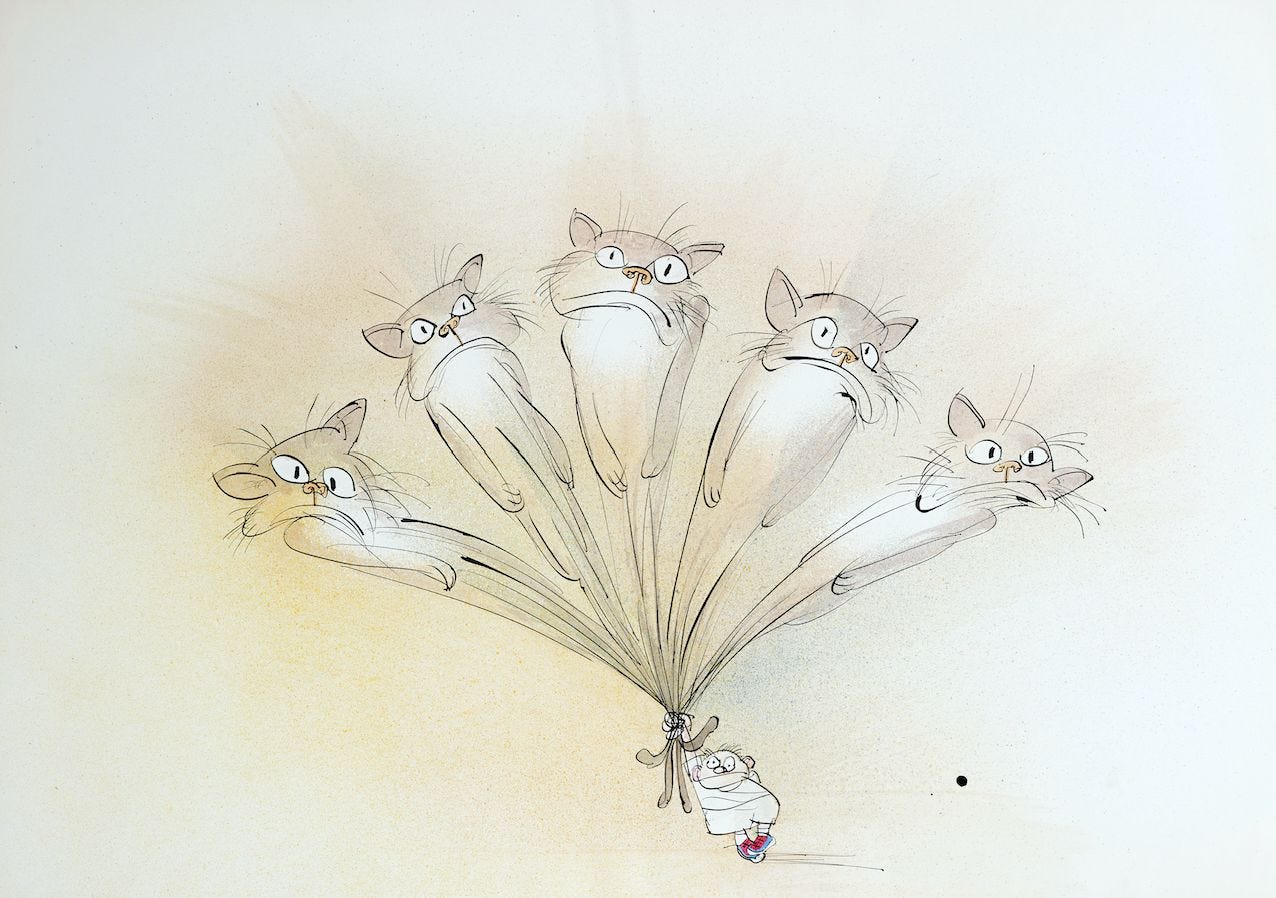
Something else you mentioned was the Ralphabet.
Sadie: That was a recent thing that we did because you'd never done one. I just said one day, why don't you start an alphabet? Then it was Ollie, your grandson, who said, oh, a Ralphabet, and that's what it became. We've turned it into a card game, and you can buy it online.
Ralph: (laughs) And if you send it, I’ll sign it for you.
I've got some background questions for you. Where were you born?
Ralph: As far as I know, in Wallasey. I was born on the 15th of May 1936. It's a long time to hang about, really.
Were you doing art when you were young?
Ralph: I don’t think I did.
Sadie: You did like to build model aeroplanes?
Ralph: Oh yes, I used to like model aeroplanes and things,. Then I got very interested in building them, making things like that. We used to get a magazine called the Aeromodeller. I don't know whether it's still done now. It was interesting to do things. I think the one thing that was good about then was that things weren't so electronic if you know what I mean. Everything was about real things, and that was quite interesting. Even when my father built me a model railway upstairs in the attic. I could go underneath, get up in the middle of it and have Hornbys going round and round. I've still got one of the trains. It still works, made out of cast iron. If they haven't gone rusty, then they're still OK. What a different time, because now we live in a fanciful world of God knows what really. It's unreal. It's a shame.
Do you play any musical instruments?
Ralph: I used to. I don't think I can do it. I used to play guitar. I learned with Allan Hodgkins. Allan used to play with Django Reinhardt. That was quite something.
Did you ever perform?
Ralph: I think I started to try doing something like that, but it didn't go on too long. I don't think I'm much of a performer.
Sadie: That's not true at all.
Ralph: Why?
Sadie: Well, you've sung in the Rogue’s Gallery at Barbican for Hal, and you've been in various television things. I think you are quite a performer. I've just found on an old VHS that I had to digitalise your Hanging Garden Centres of Kent film.
Ralph: Good lord.
Sadie: Which I really must want to sit down and watch. That was in the 90s. TVS were commissioning short films from various local celebrities or people from the art community and one of them was you, and we spent a week filming the Hanging Garden Centres of Kent. I remember it, and I was always taking pictures at the time. I was always behind the camera, and I found a film the other day.
Ralph: Wow, there we are.
When you've digitalised that, would that be anything you'd ever put online? Or is that purely personal?
Sadie: I think there's copyright issues. I did put a two-minute segment up on our socials. We did actually put a little edited bit of the opening up. But I think there are copyright issues. That's the trouble. I've got all of dad's videotapes digitalised, and I've got them all on a hard drive. But we're not allowed to show it.
Ralph: Oh, rubbish. I’m sure there’s a way.
It doesn't sound very Gonzo.
Ralph: (laughs)
What was your official occupation?
Ralph: ‘Hang about’. Well, I was a cartoonist for a while. I worked for the Sunday Times. Who else did I work for?
Sadie: You did work for the Independent for quite a while.
Ralph: Oh yes, I did.
Sadie: You told me when I was younger, or I used to hear you say on interviews, you decided one day never to expect a paycheque. If you just expect a paycheque, then you're safe. You're never going to really push yourself to be the thing you want to be. Which is a kind of independent spirit, really.
Ralph: I quite liked two guys, Ken Lewis and James Pickard, they were the artists in Kemsley Newspapers. I worked there for quite a while and used to go in daily. It was so different. Everything was different. Because we didn't have phones. I don't have one now.
Sadie: Well, we tried to get you one and you just never had it charged. The first mobile phone you ever had, you got so frustrated with it you put an pick through it. It became a sculpture called ‘Immobile.’
Ralph: Where's that now?
Sadie: It's in the cellar.
Ralph: We could get it up and display it.
Who is the most famous person you're one degree of separation from?
Ralph: Johnny Depp. Tim Robbins, another one. And Walt Disney.
Have you ever been a member of a political party?
Ralph: No, I don't think I wanted to be, actually. I was much more interested in following them and drawing them. I didn't really belong to any political party. The idea of being a fan of Farage or someone would be absolutely bloody awful.
The worst president must be Trump, the filthiest son of a bitch that ever walked God's earth. There's no such thing as God.
Who has been the best Prime Minister of your lifetime?
Ralph: Wilson, I think.
Sadie: What about in America? You liked Jimmy Carter.
Ralph: Jimmy Carter, he was a friend of mine.
Sadie: We got Christmas cards.
Ralph: Yeah, that's lovely. Him and Rosalynn, they both passed in the last couple of years. He got to 100. He played president once. He was a completely unselfish man. Perhaps that's not the right kind of character for a president. The worst president must be Trump, the filthiest son of a bitch that ever walked God's earth. There's no such thing as God. That meeting with him and Zelenskyy. Treated him terribly.
What do you think Hunter would make of what's happening now?
Ralph: I think he'd be a little shocked by it all. He was quite an honest person. I didn't find him in any way unpleasant or devious. He was so straightforward about it, you know. I think he was an honourable kind of man. He was upset about his country getting into the hands of different two-faced people and Nixon.
If someone's reading this and they wanted to see more of your work, what book of yours would you recommend?
Sadie: Depends on if they want a specific thing or an anthology. If they want a retrospective, then ‘A Life in Ink.’
What advice would you have for a young person looking to become an illustrator or cartoonist today?
Ralph: Well, learn how to draw. Really do try and go for it and don't get so consumed by the phone, but to actually get hold of a pen and or pencil and draw and try drawing directly in ink on paper and draw something. Make mistakes as you do it, not try to avoid doing mistakes. You can't help it. There's nothing to be ashamed of. You're just earnestly trying to sense the way drawing in ink on paper is interesting and tactile. I think it's better to get to touch the paper with proper ink and a pen and try different pens and sensations that come with them. That's the point. It must sense its physicality. That's the most important part of it, really.
Footnotes
This interview has been lightly edited for length and clarity.
You can read our previous interviews here.
If you want to suggest ideas or send tips for people to interview, email Steven.

